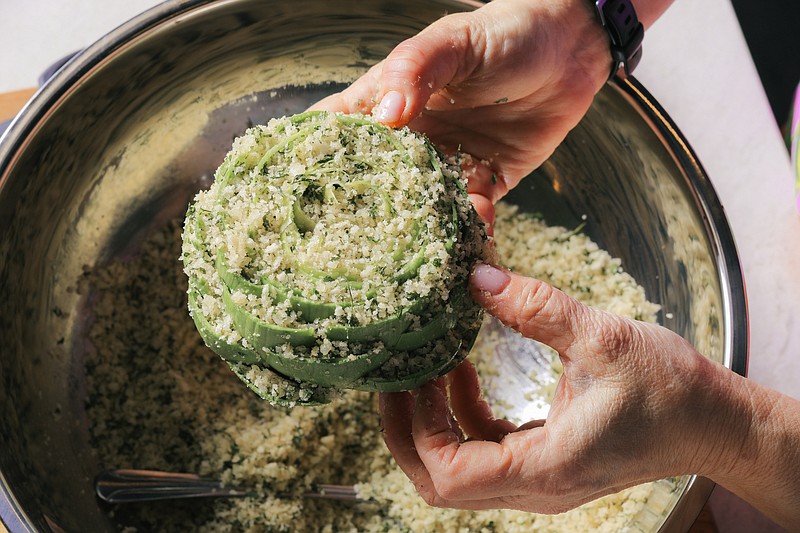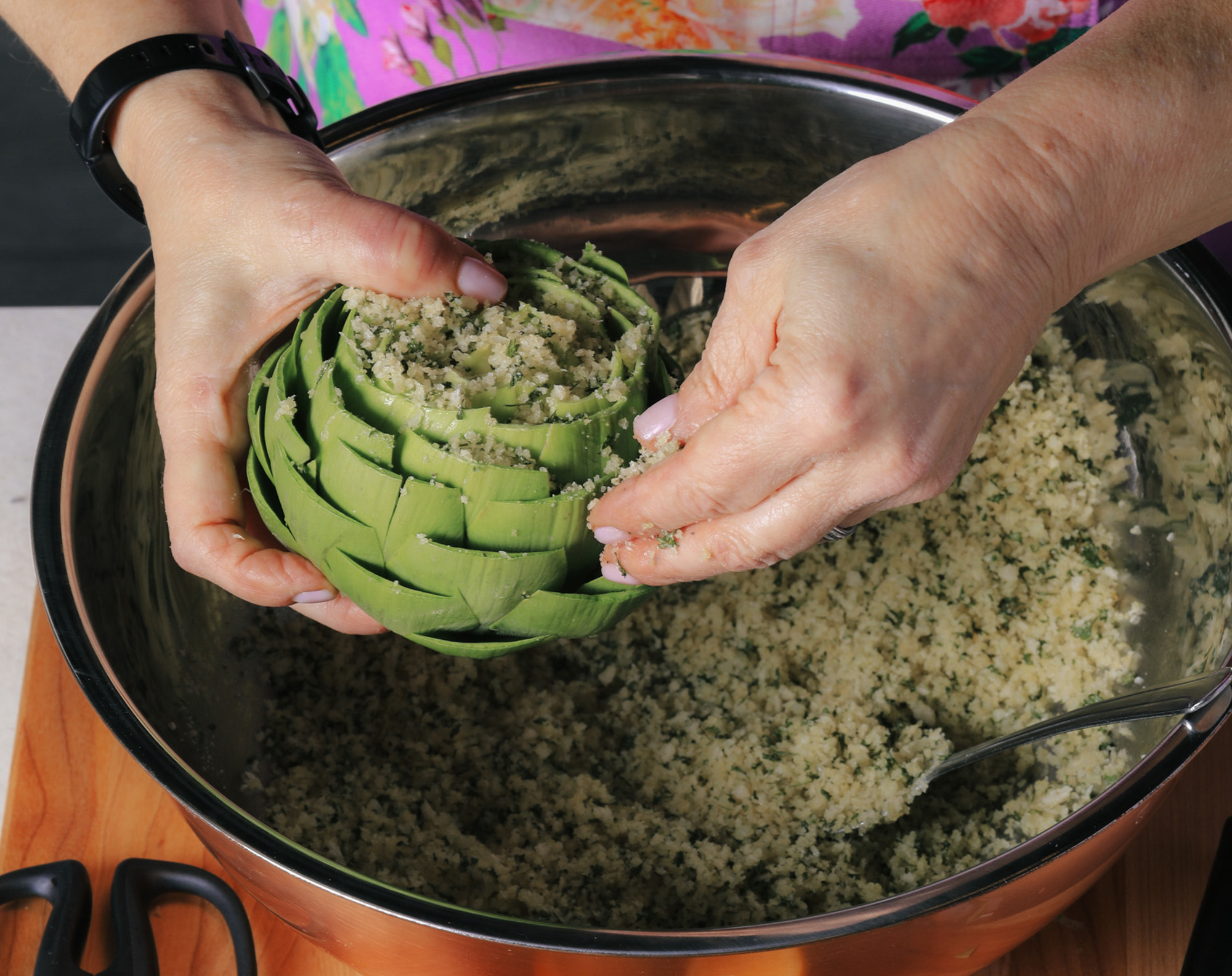Artichokes are serious business in my family. Not just any artichokes. My grandmother's stuffed artichokes. This isn't fancy, froofy food. Rather, it is down-home, roll-up-your-sleeves and eat-with-your-fingers food.
Grandmother (as we called her) migrated from northern England to the United States with her family in 1910. She learned how to make the artichokes from her Sicilian-born sisters-in-law -- my great-aunts -- who also taught her how to make many of Grandfather's favorite foods from "back home," including fried peppers, eggplant Parmigiana and baked ziti.
The artichokes were everyone's favorite, as was the family ritual of sitting at the kitchen table and slowly, slowly devouring them. Leaf by leaf, our lips and tongues gently took in the creamy-chewy stuffing; our teeth scraped out the soft inside of the bracts before biting off the bottom piece of each, which was like getting a teeny taste of the heart, before tossing the then-naked leaf into the discard pile. We would pull off the smaller, pointy and sharp interior leaves just above the hairy "choke," and bite off their tender bottoms before stopping to evaluate the choke for tenderness. Finally arriving at the heart was cause for pause -- either to crow (if it was large) or to cry "no fair" (if unusually small) -- before cutting into the tender bottoms and dabbing at any remaining crumbs and juices as though those artichokes were to be our last supper.
Grandmother's Sicilian-Style Stuffed Artichokes
- 1 ½ cups panko breadcrumbs
- 1 cup finely grated pecorino Romano cheese
- 2 tablespoons dried parsley
- 1 ½ tablespoons garlic powder
- ½ kosher salt (more if using Diamond Crystal)
- ¼ teaspoon ground black pepper
- 5 tablespoons olive oil, plus more for drizzling
- 2 jumbo artichokes or 4 large globe artichokes
- 1 lemon
- Olive oil cooking spray
Set a steamer rack into a large, lidded pot, Dutch oven or oven-safe casserole and fill the pan with water to the level of the rack.
In a large bowl, mix together the breadcrumbs, cheese, parsley, garlic powder, salt and pepper until thoroughly blended. Drizzle 5 tablespoons of the oil over the mixture and stir until the oil is uniformly distributed. The stuffing should be the consistency of grainy wet sand. Set aside.
Slice the lemon in half and rub the surface of one of the halves over your fingers. As you work with the artichokes, rub lemon on all of the exposed edges to prevent discoloration.
Hold an artichoke in your palm with the stem facing away from you. One by one, pull the small leaves off of the stem -- pull against the direction in which they grow -- and, working toward the base, pull off the smaller outermost layer of leaves as well and discard. If the outer layer of leaves on the artichoke is still very small, remove that layer as well. Lay the artichoke on its side on a secured cutting board. Using a sharp knife, cut off the stem as close to the base as possible so that the artichoke will sit flat when set upright. Rub the cut base with lemon.
Lay the artichoke on its side again and using a serrated knife, cut off the top third -- 1 to 2 inches -- of the artichoke leaves and discard. Rub lemon over the exposed edges of the leaves that remain in place. Holding the artichoke in one hand, use a scissor to snip the prickly tops off of the remaining bracts at approximately the widest part of the leaf. Start with the outer layer of leaves at the base and work inward to create an alternating pattern until all of the prickly leaf tips have been removed and the leaves make an attractive graduated pattern around the body of the artichoke.
Repeat with remaining artichokes.
Stand an artichoke upright on the cutting board. Starting from the center and working outward, use your fingers to gently pull the leaves outward to create spaces between them. Lift and hold the artichoke in one hand over the bowl of stuffing, and using the fingers of the other hand pull the leaves apart and fill the spaces with stuffing. This works best if done systematically, starting from either the inside or outside. Feel free to lay an artichoke on its side in the stuffing mixture and push stuffing into the gaps between the leaves. Use one hand to squeeze to create space and the other to fill the space. Fill each of the snipped bracts of the outer layers and as many inner leaves as the artichoke (and your patience) will allow. When it is full of stuffing, brush any straggling crumbs off the exterior so that the only crumbs visible are inside the bracts. Repeat with remaining artichokes. Depending on the size of your artichokes, you may have more stuffing than you need. Reserve any extra for another use such as stuffing other vegetables.
Bring the water in your steamer to a boil over high heat. Place the artichokes upright in the steamer basket. Drizzle each with about a tablespoon of olive oil and place the basket with the artichokes in/over the boiling water. Reduce heat to medium-low, cover and cook until very tender, about 1 hour and 20 minutes depending on the size and fibrousness of the artichokes. You should be able to easily pull out a leaf from midway between the center and the outer bracts. Check the water level every 20 to 30 minutes and add more if necessary.
Heat oven to 350 degrees. Once the artichokes are tender, remove the lid and lightly coat the artichokes with cooking spray (if necessary, use tongs to transfer the artichokes to a baking dish that will hold them snugly and spoon some of the steaming water into the bottom of the dish, so they are sitting in about ½ inch of liquid. It should not come up above the lowest/outermost bracts.) Slide the casserole/Dutch oven, uncovered, into the oven. Bake until the outer leaves have just turned golden, 5 to 7 minutes.
Serve hot or at room temperature.
Makes 2 to 4 servings.

